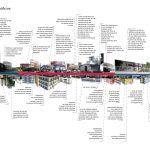Watch + Occupy + Intervene:
Center for neighbors and students of Avenida Universidad (CEVAU)
Designer: Alberto J. de la Cruz Acevedo
Posted on TOS: Summer 2013
Thesis Director: Mayra Jiménez Montano
Consultants: Andrea Bauzá + Darwin Marrero
Thesis: UPR MArch Spring 2013
Location: Avenida Universidad, Río Piedras, Puerto Rico.
TOS[er]: 11:11
Posted: Summer 2013
Alberto’s View: The Rio Piedras campus is the largest and most important of the public higher education system of Puerto Rico. With this said, its grounds and facilities do not offer a true student center that enhances social interaction between the academic communities of the different departments. But off campus, the main avenue – Avenida Universidad – on access with the university’s emblematic clock tower, has served as the center core where students of the Rio Piedra’s Campus get together for activities and services during their residence. Unfortunately, these activities do not necessarily integrate the surrounding community. Thus, the existing communities that border the avenue are in constant conflict due to the practices of the avenue’s businesses that constantly alter the peace and offend their domesticity. On investigating the historical development of the avenue, it was inevitable to recognize how the graphic texts of media and propaganda – installed on most of the facades – creates its own sense of aesthetics of the urban space. This investigation uses visualization of how we see, occupy, and, intervene in this crucial avenue.
Watch it:
For a student and resident at the University of Puerto Rico in Río Piedras, the Avenida Universidad always offers a constantly changing and unusual visual experience. The sign-scape is a peculiar one where you can grasp the many services the space offers to the student community and the permanent residents of Rio Piedras. The eye works like an evaluation machine that reads and interprets the dynamics of the space/services. The eye and the perception of the space was my tool as I investigated and explored the place to identify the pros and cons of what is happening there.
Occupy it:
The spatial effectiveness of the space is precisely the combination of services, images and events. The life of the streets, sidewalks, and, building pockets bring to the space possibilities of how it is, and can be used. The students and the community take over the streets and transform the space at night; where the main inhabitants are people and cars. Understanding the pedestrian flows and vehicular circulation were essential, in order to propose a safe space that recognized the needed interconnectivity with the local neighborhoods without sacrificing the visual character of the avenue.
Intervene it (This is the fun part!):
As part of the investigation, the interventions by artists, neighbors, students, and, visitors, were identified to recognize what is happening on the streets of Rio Piedras. Community groups and artist squads are strong forces of change along the avenue. The interventions are constantly changing and diversifying what is happening at the Avenida Universidad.
These three sections were the principal parts of my investigation. The intervention that followed joins functions and possibilities for users and the spatial quality of the university’s “main” street. As a student and designer, the space caught my interest due to the visual and experiential possibilities that have the potential of becoming a center that can unify the conflicted aspects of the permanent community and the students. CEVAU is designed as a joint/junction for these two groups and allows multifunctional spaces for activities like sports, culture, health and community services. It provides for recreational activities, such as, dance classes, gym, and skateboard sports, among others. The programmatic proposal challenges the present character of the avenue where alcohol consumption often takes the upper hand; corroding the necessary sense of security of both the academic and adjacent residential communities. The activities of the center are put on view for the pedestrians and users, bringing to the street a new scenographic feeling where the signs and human actions are fused to generate a vivid visual experience. The ultimate goal is to expose creative and constructive ways of using our free time.
- Watch + Occupy + Intervene: Avenida Universidad.
- Design Diagram
- Program Diagram
- Location / Perspectives
- First Floor Plan
- Section A-A / Perspective View
- Model Photographs
- Watch AM
- Second Floor Plan
- Watch PM
- Building Description
- Zone Data Infographic
- Occupy
- Detailed Section














